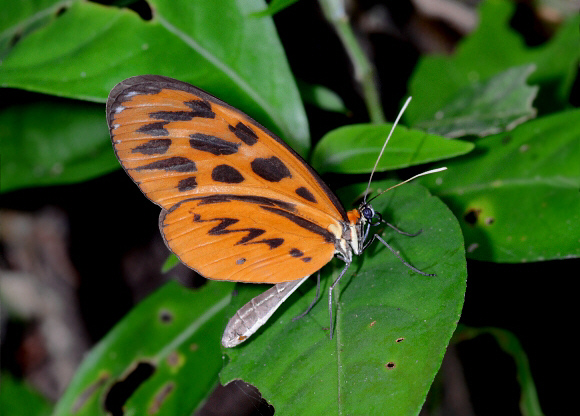
Introduction
The Ithomiini comprises of 376 known species, although it is likely that at least another 30 will be discovered in the near future. All are confined to the neotropical region. Ithomiines are unpalatable to birds, and are consequently mimicked in appearance by many other species.
These include other unpalatable species ( Müllerian mimics ), not only from the Ithomiinae but also from several other butterfly families. There are also a large number of edible species ( Batesian mimics ) which have evolved similar patterns. Birds have the ability to memorise butterfly patterns and so learn to avoid eating noxious species, but are also fooled into ignoring similarly marked edible species.
Ithomiines are characterised by having small eyes, slender abdomens and long drooping antennae that lack distinct clubs. Males have a plume of long androconial scales or “hair pencils” on the costa of their hindwings. These are hidden from view when the butterflies are at rest, but are displayed when the wings are held open during courtship. Other Ithomiine characteristics include a very slow and deep wing beat, and a preference for inhabiting the darkest recesses of the forest understorey.
The genus Forbestra consists of 3 species – equicola, olivencia and proceris. All are ‘tiger-complex’ species with elongated wings, and have similar markings. The most widely distributed species is equicola which is found in Venezuela, Surinam, Guyana, Brazil, Ecuador and Peru.
Forbestra olivencia is found in Brazil, Ecuador, Peru and Bolivia. There are 7 subspecies.
Habitats
This species inhabits lowland rainforest at altitudes between sea level and about 500m.
Lifecycle
To be completed.
Adult behaviour
The butterflies are normally encountered singly. They are rather inactive, and fly slowly with deep wing-beats. Males visit Eupatorium flowers from which they sequester pyrrolizidine alkaloids which confer toxic qualities to the butterflies, thus deterring bird attacks. The chemicals are also used in the production of pheromones. These are stored in plumes of androconial scales located on the inner margin of the forewings. The presence of passing females stimulates the males to slowly fan their wings, thereby releasing the scents and enticing the females into copulation.
